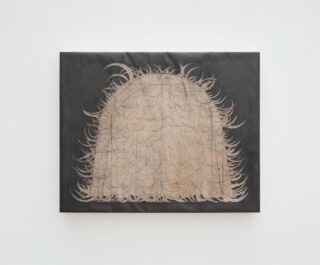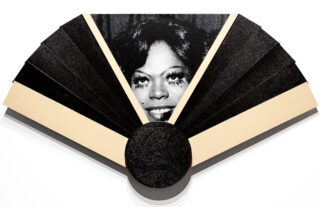Mic Check


Mic Check features the work of artists Lindsay Adams, Jermaine “jET” Carter, Kamari Carter, Alanna Fields, Cameron A. Granger, Imar Lyman, Kai Jenrette, and Darol Olu Kae. Taking cues from the sonic landscape and cultural legacy of U Street Corridor, historically known as “Black Broadway,” the group exhibition spotlights music’s presence, politicization, and intergenerational resonance within Black American communities. Curated by Anisa Olufemi, director of programs and curator, Mic Check will feature sound, drawing, video, photo, and sculpture—including new works created especially for this exhibition.
Select works from Fields’ Les Girls series open fanned windows into the past, spotlighting archival photographs of Black Drag and Femme Queen icons who paved the way for queer Ballroom culture in 1960s and 70s. Granger’s pseudo-documentary ponders the ominous presence of black holes, searching for the memory of people and places that seem to vanish within them. Dancing between sculpture and illustration, Jermaine “jET” Carter’s work pays tribute to jazz and go-go music’s influence within DC’s collective memory. Kae’s short film Keeping Time (2023) ponders the challenges and necessity of stewarding musical tradition across generations. Kamari Carter’s installation-based and 2D works call attention to the weight of silence, and the invasiveness of policing. Both Adams and Jenrette offer abstract drawings that conjure rhythm in gesture and spirit in negative space.
Music holds the unique capacity to transcend the bounds of borders and built-environment with echo and bounce. From Washington, DC, to East Cleveland, Kansas City to Crenshaw, Mic Check celebrates music as a form of power, and a vital tool of resistance. Reflecting on the exhibition’s theme, curator Anisa Olufemi shares the following:
“This neighborhood that Hamiltonian Artists calls home has served as fertile ground for Black American cultural production for over three generations. In the thick of Jim Crow, jazz and blues icons like Duke Ellington, Billie Holiday, and Louis Armstrong found respite. Chuck Brown and the Soul Searchers rose from the ashes of the ‘68 riots with go-go. Black music and performance is an inextricable part of the district’s social, cultural, and political fabric. Today and always, musicians and artists of all disciplines spark community in times of division, invoke memory despite cultural amnesia, and conjure site amid redevelopment and rampant displacement. I am thrilled to share an exhibition that is so deeply inspired by the radical past, present, and futurity of U Street, a place I and so many others hold dear.”
Artists
Lindsay Adams (b. 1990, Washington, DC) is a writer and painter working across traditional mediums. Employing her educational foundation as a social scientist, with a background in foreign relations, sociology, and cultural anthropology, she systematically engages in her work with precise critical analysis and a perceptive understanding of the complex fabric of social dynamics.
Jermaine “jET” Carter (b. 1998, Washington, DC) is an interdisciplinary artist from Southeast Washington, DC, whose work explores memory, cultural preservation, and speculative world-building through painting, sculpture, digital media, and animation.
Kamari Carter (b. 1992, Los Angeles) is a New York-based artist working primarily with sound, video, installation, and performance. His practice circumvents materiality and familiarity through a variety of recording and amplification techniques to investigate notions such as space, systems of identity, oppression, control, and surveillance. Driven by the probative nature of perception, Carter’s work seeks to expand narrative structures through sonic stillness and found objects.
Alanna Fields (b. 1990, Maryland, USA) is a mixed-media artist and archivist whose work both deconstructs and reconstructs Black queer memory and history through a multidisciplinary engagement with photographic archives.
Cameron A. Granger (b. 1993, Cleveland, Ohio) is Sandra’s son and came up in Cleveland, Ohio. He likes pigeons, video games, and memes. Lately he’s been thinking about how myth making and narrative have been used as a means to police the imagination.
Imar Lyman [Hutchins] is a collagist and printmaker based in Washington, DC. Most recently he has been extending his practice into glasswork. This year he was honored to create his first major work in glass—entitled Sunbursts Appear in Dark Disguises—for the lobby of the newly-constructed Cedar Hill Hospital in Ward 8, Washington, DC.
Kai Jenrette uses the language of craft and design to explore how we construct identity through making. The pieces strive to become themselves—just as people do—navigating constraints, surroundings, and ideals of appearance. They are drawings trying to live their lives as drawings, with the same confusion, effort, and hope that comes with being human.
Darol Olu Kae (b. 1984, Los Angeles) is a filmmaker from and based in Los Angeles. Kae’s artistic practice disrupts conventional narrative structures of storytelling through its dynamic treatment of sound and image. His highly collaborative, research-based approach to filmmaking grounds itself in the nuance of black expressive modalities in America and challenges the medium to render the full complexity of black being visible in cinematic terms.
Downloads
Checklist
Programs
Opening reception
Saturday, November 8, 5–7pm
Curator Tour
Saturday, November 15, 1–2:30pm
News & reviews
Coming soon